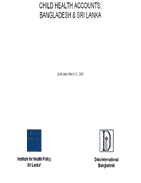Results of the WHO-sponsored pilot study in Bangladesh and Sri Lanka to use health accounts methods to estimate and track spending for child health.
Abstract
This report presents the findings and work of a study commissioned by WHO to estimate child health expenditures in Bangladesh and Sri Lanka, using a health accounts approach. The main purpose of the study was to demonstrate the feasibility of such an approach at a low cost, and this objective was achieved. The report is structured in three parts. The first part provides a brief introduction and overview of the health system and health conditions in the two countries. The second part reviews and discusses the methodological approach used. This is followed by a section, which gives additional information on the data and methods used in each country analysis. After this, the findings and conclusions are presented, with the detailed tables of results presented in the Appendix to the report. The main conclusions of this report are: (i) Child health spending in Bangladesh and Sri Lanka was US$ 11 and US$ 16 per child in 2000. Half to two-thirds of this financing comes from households and other private sources in the two countries. (ii) The level of child health spending itself does not appear to be the main barrier to improving child survival in Bangladesh, as the time series data show that Sri Lanka was achieving far better results in the early 1990s, despite having lower levels of total and public sector spending on child health. The results underline the need to think more about the role of technical efficiency in health systems in order to achieve better outcomes in child survival. (iii) The existence of health account systems adhering to the WHO-recommended OECD SHA statistical standard substantially facilitates the task of estimating child health expenditures and producing comparable statistics for different countries. In particular, the classification of expenditures by function in the SHA is of fundamental importance and benefit for this type of work. (iv) Investment in health accounts capacity building in developing countries would have the additional benefit of reducing the cost and increasing the feasibility of producing regular estimates of child health resource flows at the country level.
Content
1. Introduction
2. Country Situations
2.1 Health and population status
2.2 Health Systems
Bangladesh
Sri Lanka
3. Methods
3.1 Objectives
3.2 Concepts
Health expenditure scope
Child health expenditure boundary
Child health services
3.3 Health Accounts Framework
OECD System of Health Accounts
Comparability of Bangladesh and Sri Lanka health accounts estimates
3.4 Estimation strategy
3.5 Limitations of analysis
Limitations on account of resource limitations
Limitations on account of conceptual limitations
4. Country-specific data and methods
4.1 Bangladesh
Health accounts
Household survey data Apportionment rules
4.2 Sri Lanka
Health Accounts
Apportionment rules
Household survey data
5. Results
5.1 Total expenditures for child health
5.2 Financing of Child Health Services
5.3 Functional use of child health spending
5.4 Policy Implications
6. Implementation experience
6.1 Feasibility
Specific issues
6.2 Methodological recommendations
Appendix: Child Health Accounts Tables
Bibliography

